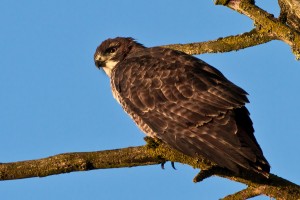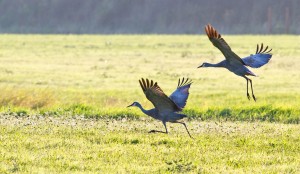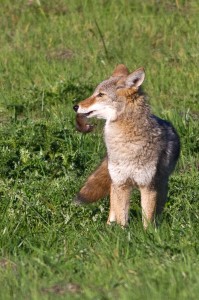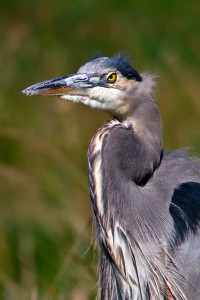Welcome to my new site and blog– launched October 2010. It’s all new to me and you may run across goofs and oopses. Please let me know if anything looks way out of whack! I haven’t added a whole lot of pictures yet but I am working on them as we speak and trying to write something about each one. Rolling your cursor over a thumbnail will give you the choice of reading details about the photo (I’m still working on adding the photos’ details, so please excuse if you come across a photo that has no additional info!), or seeing a full-sized image. The most direct way to access the photos I’ve posted is to click on the main navigation bar at the top of the Homepage, specifically, BIRD PHOTOS and NON-BIRD PHOTOS. These will produce a drop down menu that gives you access to all available categories of birds and animals.
Following is an account of my day, Oct. 5, 2010, at the Ridgefield NWR from my own point of view, as an amateur bird & wildlife photographer. I love exchanging stories about how a special shot was made and what happened to get it. It’s analogous to, say, people who fish– exchanging how they caught the big one or of golfers exchanging stories about specific holes over lunch in the clubhouse after the round. For a bird photographer to do this, could be as boring as all get out for some, but may actually interest other amateur bird photographers–and maybe folks who are bird enthusiasts without cameras! Please use the comment block on my blog to reply and even add your own stories–I want this to be a two way street. I enjoy hearing others’ stories, too! Thanks for visiting!
This is my first blog post, so I’ll go into a little more detail this time, describing the day. I arrived at the Ridgefield refuge (in Washington state) at true sun up, about 7:15 a.m. It’s fairly clear and the sun won’t actually peak up over the ridge for about another 30 minutes. So I make sure my flash is set up on my camera for low light situations and camera settings are correct. I make sure my bean bag is in place in the driver’s window and that I have my small wooden stool set up in the passenger’s seat for me to lean on for shots out the passenger side window. Beings it’s about 40 degrees (F) out and there is a slight breeze, I turn on the truck heater a little to keep warm.
I take off on the 4.2-mile auto tour and round the corner at the hunter’s gate. Just past post #5, I spot a beautiful Red-tailed Hawk on a branch that actually protrudes out over the road. The bad thing is that he is up fairly high so this isn’t the best perspective. But the sky is blue and, facing west, I am getting great morning light and the shot is unobstructed. Refuge rules for this time of year require me to stay in the truck so I stop sideways on the road, getting an easier shot pointing up from my window. I check my rear view mirror before parking like this to make sure no one is approaching immediately and might want to pass. I get about a half-dozen shots of the hawk before it flies off. Here’s one of the frames:
(Click on any of these inserted photos for a larger view).
Not exactly a wall hanger but it gives you an idea of the opportunity I had. During the next mile and a half or so (driving very slowly), I notice a Fish & Wildlife Service worker passes me in his truck, then a little later, I pass him, and so on and so forth. I appreciate these folks and the job they do but I don’t really like being in a position where they flush the wildlife away in front of me (they usually go relatively fast and are more concerned about getting to where they are going than flushing the wildlife). So, we’re on the straight stretch almost to the corner prior to post 12. The F&WL guy is parked up ahead of me where he got out to do what he had to do. I stopped several hundred feet behind him and was planning to let him get back in his rig and drive on ahead of me. He did get back in his truck and started to pull out, then I noticed he stopped and backed up into the same parking position he was in before. I thought, Ok, now what? Just get going so I can take some pictures! He then gets out of his rig and walks toward me and up to the window of my truck. He tells me there are several Sandhill cranes just around the corner by post 12 and he didn’t want to drive by there without giving me a chance to go ahead and get some shots of them. I said thanks a lot, and couldn’t believe my ears! Here I was just complaining to myself about this guy and now he interrupts his work to let me take pictures. I drive up toward the cranes and they aren’t very far from the road but I know if I drive too close, they are gone. So I took some shots from about 150 feet, against the sun, and with the cranes taking flight. This isn’t a good spot to be taking photos from facing east unless it’s much later in the day. The resulting shot was certainly backlit but one can still see some detail on the cranes, so it wasn’t a complete failure.
On my second time around the auto tour loop, I was fortunate to come across a coyote in the field on the straight away heading toward the main visitor center. He/she was not that far off the road (maybe a little over 100 feet). The light is perfect here early in the day for shooting raptors who hunt on the ground and harriers who fly low to the ground in a north/south direction…it’s also great if you see a coyote! I must have come upon this one just as it had entered the field because as soon as I turned off my truck engine, it began hunting for rodents. My 4th frame of many, was a pouncing shot–my first ever capturing a coyote’s surprise attack. And the coyote was amazingly efficient. These two shots were taken only 8 seconds apart:
I love the fast burst speed of the Canon 7D at 8 fps!
I also got a shot of a Common Snipe and a Pied-billed Grebe during the day, which I may post to my galleries here and/or on Flickr.
Oh, and one other thing I tried today on this shoot was to put my 1.4X converter on my 400mm lens and attempt to focus using the live view feature and the 10x zoon ability of the 7D on the LCD screen. As most of you know, adding the converter to the 400mm lens, deactivates auto focus on the Canon 7D (and other cropped sensor models). So to use the converter, you must rely on manual focusing, and I’ve had trouble being successful at this in the past using the viewfinder. So I thought I’d try manual focusing through the LCD screen in live view, with the zoom turned way up. I looked for a relatively stationary bird to test this on. The perfect model was a Blue Heron basking in the sun about 120 feet away.
I had good lighting on this heron and he was at a super position with a good view of the eye. I set the camera on the bean bag, aimed, and turned on live view with the zoom. Wow, his eye basically filled the LCD screen from over a hundred feet away! Turning the manual focusing ring was tricky though since it took very little movement to go past the in-focus point, and the camera has to be PERFECTLY still at 560mm + 10X zoom. A fine tuning focus adjustment wheel would be cool to have in this situation.
I take a few frames of the heron, readjust focus, and take a few more in case I was off on the first burst. I then turn on the movie mode just for the heck of it to see how that looks. When I got done here, I headed down the gravel road a little ways and spotted another blue heron off to my right, which had just nabbed itself a snake–in perfect light. But, of course, he decided not to eat the snake right there but instead, fly across the road in front of me to my right side and land about 200 feet away, with the sun now on the wrong side of me. I decided to take a video of him eating this snake, so I’m shooting out the passenger side window with 560mm of lens and just a lousy pillow under the camera (which I HAVE to replace soon with a second bean bag!). I make my focus adjustment as quickly as I can and set exposure and start shooting the movie. It takes over 5 – 1/2 minutes for the heron to finally consume the snake. Luckily I had the 1.5 GB of space left on my 16GB card to hold the video. Below is the still picture I took with the 560mm combo and the video of the heron consuming the snake. It’s a long video but I think it is worth watching, as it gets better as you get further into it. You’ll see the snake making some amazing moves in his attempt to survive.
Here is the still photo of the heron:
And here is the link to the video on YouTube: http://www.youtube.com/watch?v=fnm9IqGMeZk
That about made up my day at the Ridgefield Refuge on this day! I was there for about 7 hours, which is about my average visit–I usually only visit once a week. This turned out to be a longer entry than I thought it would be and I’m pretty sure most subsequent entries will be shorter. I did want to give readers a flavor of how I spent the day and some of the details that go into it. This surely added to the word count. Thanks for tuning in and I hope you’ll come back to see what’s in store for my next outing!
P.S. Please check out my posted BIRD PHOTOS and NON-BIRD PHOTOS in the main navigation area at the top of the Homepage and read more about me in ABOUT! Feel free also to visit my Flickr photostream easily by clicking into Flickr in the bottom right corner of the Homepage. I’ve got hundreds of images on Flickr and will continually add more both to Flickr and this site.





You’re off to a great start here Dennis! Very nice looking blog. I work full time while I am going to school, so my opportunities to get out to local refuges are limited. So, this makes blogs like what yours will be and photos on Flickr quite valuable to me. Not only do I enjoy your high quality bird photos, but the information is valuable as well. So thanks in advance, and I look forward to reading about your next trip!
Eric, I can’t believe how busy you must be with full time work and school! Very kind of you to stop by and take a look at the site/blog. I, too, enjoy your photos on Flickr! Hope you get the opportunity to get out and shoot soon! Take care and see you online soon!
Your video was so amazing, Papa (as is the accompanying pic). What a great capture of nature in action! Love it! 🙂